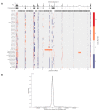Genome Organization and Copy-Number Variation Reveal Clues to Virulence Evolution in Coccidioides posadasii
- PMID: 36547568
- PMCID: PMC9782707
- DOI: 10.3390/jof8121235
Genome Organization and Copy-Number Variation Reveal Clues to Virulence Evolution in Coccidioides posadasii
Abstract
The human fungal pathogen Coccidioides spp. causes valley fever, a treatment-refractory and sometimes deadly disease prevalent in arid regions of the western hemisphere. Fungal virulence in the mammalian host hinges on a switch between growth as hyphae and as large spherules containing infectious spores. How these virulence programs are encoded in the genome remains poorly understood. Drawing on Coccidioides genomic resources, we first discovered a new facet of genome organization in this system: spherule-gene islands, clusters of genes physically linked in the genome that exhibited specific mRNA induction in the spherule phase. Next, we surveyed copy-number variation genome-wide among strains of C. posadasii. Emerging from this catalog were spherule-gene islands with striking presence-absence differentiation between C. posadasii populations, a pattern expected from virulence factors subjected to different selective pressures across habitats. Finally, analyzing single-nucleotide differences across C. posadasii strains, we identified signatures of natural selection in spherule-expressed genes. Together, our data establish spherule-gene islands as candidate determinants of virulence and targets of selection in Coccidioides.
Keywords: Coccidioides; copy number variation; fungal pathogens; genome organization; virulence.
Conflict of interest statement
The authors declare no conflict of interest.
Figures





Similar articles
-
The WOPR family protein Ryp1 is a key regulator of gene expression, development, and virulence in the thermally dimorphic fungal pathogen Coccidioides posadasii.PLoS Pathog. 2022 Apr 6;18(4):e1009832. doi: 10.1371/journal.ppat.1009832. eCollection 2022 Apr. PLoS Pathog. 2022. PMID: 35385558 Free PMC article.
-
Life Cycle Dominates the Volatilome Character of Dimorphic Fungus Coccidioides spp.mSphere. 2021 Apr 14;6(2):e00040-21. doi: 10.1128/mSphere.00040-21. mSphere. 2021. PMID: 33853870 Free PMC article.
-
Optimizing in vitro spherulation cues in the fungal pathogen Coccidioides.mSphere. 2025 Jan 28;10(1):e0067924. doi: 10.1128/msphere.00679-24. Epub 2024 Dec 17. mSphere. 2025. PMID: 39688406 Free PMC article.
-
Genomics in Coccidioides: insights into evolution, ecology, and pathogenesis.Med Mycol. 2014 Feb;52(2):149-55. doi: 10.1093/mmy/myt001. Epub 2013 Dec 12. Med Mycol. 2014. PMID: 24576996 Review.
-
Immune Response to Coccidioidomycosis and the Development of a Vaccine.Microorganisms. 2017 Mar 16;5(1):13. doi: 10.3390/microorganisms5010013. Microorganisms. 2017. PMID: 28300772 Free PMC article. Review.
Cited by
-
From soil to clinic: current advances in understanding Coccidioides and coccidioidomycosis.Microbiol Mol Biol Rev. 2024 Dec 18;88(4):e0016123. doi: 10.1128/mmbr.00161-23. Epub 2024 Oct 4. Microbiol Mol Biol Rev. 2024. PMID: 39365073 Review.
References
Grants and funding
LinkOut - more resources
Full Text Sources
Miscellaneous

